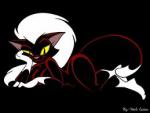'Why Is America Always Divided 50–50?
Despite wrenching economic and political changes in the country, Democrats and Republicans keep finding themselves nearly tied in election after election.
[...] Democrats controlled the House from 1955 to 1995[...] Now the chamber is about to change hands for the fourth time in 15 years. The difference in the number of congressional seats held by the majority and minority parties has collapsed too. Between 1959 and 1995, the House majority was never less than 50 seats and repeatedly hit the triple digits. Today, the Democrats have only eight more seats [...] The popular-vote margin in American presidential elections has diminished too. In five of the past six contests, fewer than five percentage points separated the winner from the loser.
[...] Our coin-toss elections are not the result of having two parties competing for an engaged and persuadable electorate. They are at least in part a product of our political stasis and extreme polarization. [...] both parties are “insecure” in victory and hyper-engaged in a “perpetual campaign” against the other side.
There is no simple explanation for why this is happening. I had at first figured it had something to do with game theory. You have two parties. Each has deep resources and strong incentives to win over and thus reduce the number of middle-of-the road voters. The parties zig, they zag, they revise their arguments. They both get better at winning elections, beefing up their use of voter data, opposition research, on-the-ground organizing, and gerrymandering. In time, each gets good enough that the contests start to come out 50–50.
That hypothesis might be partly true, [...] But he pointed to historical factors that, in his view, offer the strongest explanation for today’s political environment. During the Great Depression, the Democrats became a nearly unshakable majority party in Congress, buttressed by the votes of white southerners and New Deal supporters across the country. But in the 1960s, white southerners began migrating to the Republican side in a revolt against national Democrats, who backed civil-rights legislation and redistributive policies that aided Black Americans. As the political saliency of the New Deal faded, the parties became more competitive and their voter bases more equal. “The thing that made us so unusual for so long was the South,” [...] “We had a one-party state within the country.” Its disappearance paved the way for our 50–50 electorate and pendulum-swinging government.
[...] Republicans became a “full-fledged, politically viable national alternative to the Democrats” only in 1980, when Ronald Reagan won the presidency on a low-tax, small-government platform. The same year, Republicans took the Senate for the first time in a quarter century. And in 1994, they broke the Democratic grip on the House.
A related explanation for today’s instability has to do with the growing polarization of the two parties. [...] Voters changed too: They quit splitting their tickets and became more reliable supporters of one side or the other. They “sorted” along political lines, becoming more likely to live around people who vote like them, as well as becoming more ardent ideologically, with fewer cross-cutting social ties[...] They also became more averse to partisans of the other side. That polarization has contributed to our close elections: When almost all voters have already made up their mind, there just aren’t that many people for politicians to persuade. [...]
The competitiveness of American elections also seems to have made the government less responsive to the wants and needs of voters—not more so, as you might normally expect. “In the current context, you have party control that hinges on small margins of the vote share in a small number of races,” [...]
[...] Being banished to electoral purgatory every now and then encourages political groups to reform and change. It encourages them to think about their long-term value proposition, not just how to gain a few thousand more votes [...] It forces them to adapt to the needs of average voters. Our political climate has diminished that constructive pressure'
Why Do American Elections Always End Up 50–50?
Tempting to think in terms of entropy or near-equilibrium... adversarial networks etc. Article doesn't mention how common this in other democracies though.
Possibly related:
'
[...] possibility: the public is simply a thermostat. When government spending and activism increases, the public says “too hot” and demands less. When spending and activism decreases, the public says “too cold” demands more. [...] 1995 paper [...]:
We observe that the signals the public sends to policymakers, in the form of preferences for “more” or “less” spending, react to changes in policy…[T]here is negative feedback of spending decisions on the public’s relative preferences, whereby the public adjusts its preferences for more spending downward when appropriations increase, and vice versa.
[...] in [...] The Macro Polity, refer to “the governing system as a thermostat.” Erikson et al. show that the public’s “mood” — a general measure of the policies it desires — moves in the opposite way as policy:
The correlation between policy innovation in one administration and before-after mood change is a strongly negative -0.76…The more liberal the policy stream, the more conservative is the change in mood. Notably, the most liberal presidency (Johnson’s full term ending in 1968) is associated with the greatest public reaction in the conservative direction. Similarly, the conservative presidencies of Reagan and Eisenhower moved the public in a liberal direction.
Brooks is wrong to assume that the public’s reaction to Democratic policies indicates a enduring ideological disjuncture or a failure of public relations. The public may not be more conservative. It may simply be saying “too hot.” [...]
Current trends would not show that Democrats have been unusually unsuccessful in moving public opinion but that policy ideology in public opinion typically moves against the direction of policymaking. The public requests liberal policies, gets them, and then moves in the other direction; they then get more conservative policies and move against them.
[...] The ebb and flow is the more important dynamic.'
Monkey Cage (themonkeycage.org)
Until the near-equilibrium is replaced with the sheerer equilibrium of authoritarianism?...

 Help
Help




















